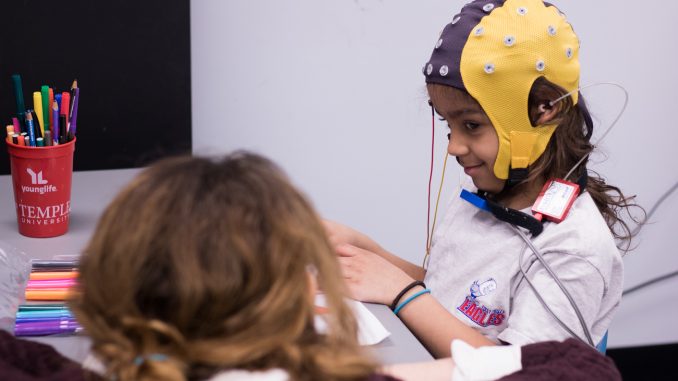
Staci Weiss and a group of research assistants scouted day cares, public pools and community centers to get parents’ permission to study their children’s brains.
The group dropped off flyers, sent postcards and explained to Philadelphian families how they could contribute to a neuroscience study and earn some money.
“For a lot of the families coming in, it was their first interface with science, especially as a participant,” said Weiss, a fourth-year psychology Ph.D. student. “It’s a rare opportunity for kids.”
Weiss and psychology department chair Peter Marshall, in partnership with the University of Washington’s Institute for Learning and Brain Sciences, conducted a first-of-its-kind neuroscience study on 80 children ages 6 to 8 in Weiss Hall from 2016-17.
Because of the first study’s success, the team is now recruiting a new round of children to test their responses to signs, sounds and sensations using an electroencephalogram test, which measures electrical activity in the brain by attaching small, metal discs to the scalp. The participant trials will run through September on a rolling basis.
During the studies, researchers measure the children’s ability to anticipate touch in relation to their executive functioning skills, or cognitive skills that involve mental control and self-regulation, like their ability to focus.
“This foundational ability to try and predict what’s about to happen and adjust your behavior accordingly, before that occurs, is foundational to anticipation I think, and I think that that may be important in ways that are more broad,” Weiss said.
In the first study, the children sat in front of a screen displaying an arrow indicating which hand to expect a touch on, and an inflatable balloon-like device tapped their middle fingers about one and a half seconds later. Then the electroencephalogram test would map the data on a screen.
The “scalp maps” show brain activity moments before a child anticipates a touch to their hand. The children then demonstrate their ability to focus and perform executive functioning skills on activities afterward.
Weiss first came up with the research idea in 2015 when she worked with Marshall to create a project proposal for the National Science Foundation Graduate Research Fellowship Program. Many executive function tests involve responding to visuals or sounds, but not many study the effect of touch on children, Weiss said.
“I was wondering if some of the variances in activity might be due to how well children were able to attend and focus in expectation of sensations,” Weiss added.
Weiss was interested in working with children and infants because studying them helps to understand how behavior develops and changes based on childhood experiences, she said.
The study also connected with Marshall’s own research interest of infants and children.
Marshall’s favorite part of the studies is looking at the “scalp maps” because of how clearly they show the brain’s response to anticipation, he said.
“Understanding how kids’ brains work and understanding the kinds of questions that we’re asking can only be addressed with the help of families that come in from the community to help us with that,” Marshall said.
The researchers spent a year writing the first study’s results and published them in the November 2018 issue of “Developmental Cognitive Neuroscience,” a journal on cognitive brain development. The results, which included 80 of the participants, provide insight into when the ability to focus a child’s attention is needed, like during academic performance and mindfulness meditation, Marshall said.
Jeb Taylor, a senior philosophy and psychology major who worked as an undergraduate research assistant on the first study, enjoyed teaching the children about science, he said.
“Kids really get this image of science as these weird old people in lab coats who do things with beakers and chemicals,” Taylor said. “We really wanted to show the more humanized side of science, which is really a fun and interactive experience within which they’re not subjects, but participants.”


Hello. excellent job. I did not expect this. This is a splendid story.
Thanks!